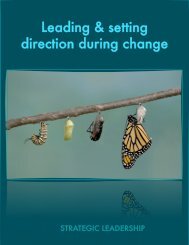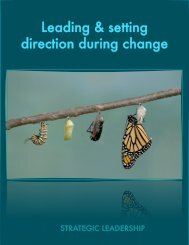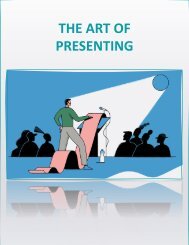2020 iLEAD e-book
- No tags were found...
Create successful ePaper yourself
Turn your PDF publications into a flip-book with our unique Google optimized e-Paper software.
Conflict can be a good thing; the most creative solutions and new ideas often emerge from the cut and thrust<br />
of debate. But, at other times, it can damage teams and dramatically lower morale.<br />
When it comes to putting your conflict resolution skills into practice, there are ten steps you need to follow.<br />
Step one is to be aware of conflict<br />
Keep your eyes and ears open for any early signs of conflict. Don’t turn a blind eye to symptoms of hidden<br />
conflict. Ignoring it may be an easy option initially, but in most cases it will backfire.<br />
Step two is to set the scene<br />
Make sure people understand that the issue may be a mutual problem best resolved through discussion and<br />
negotiation. Discourage fight-‐or-‐flight, passive or aggressive behaviours. Encourage assertiveness.<br />
The third step is to gather information<br />
Take time to find out what has happened, who is involved, how people are feeling, and what the issues are.<br />
Avoid being pulled into the middle of the argument and taking sides. Practice empathetic listening.<br />
The fourth step is to identify the root cause of the problem<br />
Try to understand why team members are arguing with each other, whether there is a deeper personality<br />
conflict or whether one member is being stubborn. Is the root cause a behaviour or a situation?<br />
The fifth step is to brainstorm solutions.<br />
Try to make this as fair and balanced as possible – everybody should feel they've been involved in the<br />
discussion. Avoid dictating a resolution. Point out the importance of agreeing to disagree on certain issues.<br />
Step six is to agree on the way forward.<br />
At this stage, the conflict might already be resolved if both sides understand one another’s positions.<br />
Step seven is to remind team members to forgive<br />
Once your team has resolved a conflict, remind people to forgive one another for any hurt feelings or<br />
damaged egos. Point out that forgiveness is not a sign of weakness or of a propensity to "give in."<br />
Step eight is to Implement what has been agreed<br />
It is important to ensure that everyone is clear about what has been decided and takes personal responsibility<br />
for any actions that have been agreed.<br />
Step nine is to evaluate how things are going<br />
Don’t assume that the issue has been finally resolved. Continue to keep an eye on the situation and evaluate<br />
how well the solution is working. If the problem reappears it may be necessary to take further action.<br />
Step ten is to consider preventative strategies for the future<br />
Think about the lessons that can be learned from the conflict and the way it was handled. What could be done<br />
better next time?<br />
Conflict can be damaging and stressful if it's not handled correctly. But learning how to manage different<br />
opinions and positions can help everybody grow

















